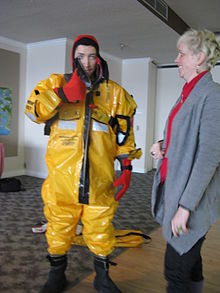
An immersion suit, or survival suit (or more specifically an immersion survival suit) is a special type of waterproof dry suit that protects the wearer from hypothermia from immersion in cold water, after abandoning a sinking or capsized vessel, especially in the open ocean. They usually have built-on feet (boots), and a hood, and either built-on gloves or watertight wrist seals.
The first record of a survival suit was in 1930 when a New York firm American Life Suit Corporation offered merchant and fishing firms what it called a safety suit for crews of ocean vessels. The suit came packed in a small box and was put on like a boilersuit.
The ancestor of these suits was already invented in 1872 by Clark S Merriman to rescue steamship passengers. It was made from rubber sheeting and became famous by the swim records of Paul Boyton. It was essentially a pair of rubber pants and shirt cinched tight at the waist with a steel band and strap. Within the suit were five air pockets the wearer could inflate by mouth through hoses. Similar to modern-day drysuits, the suit also kept its wearer dry. This essentially allowed him to float on his back, using a double-sided paddle to propel himself, feet-forward. Additionally he could attach a small sail to save stamina while slowly drifting to shore (because neither emergency radio transmitters nor rescue helicopters were invented yet).